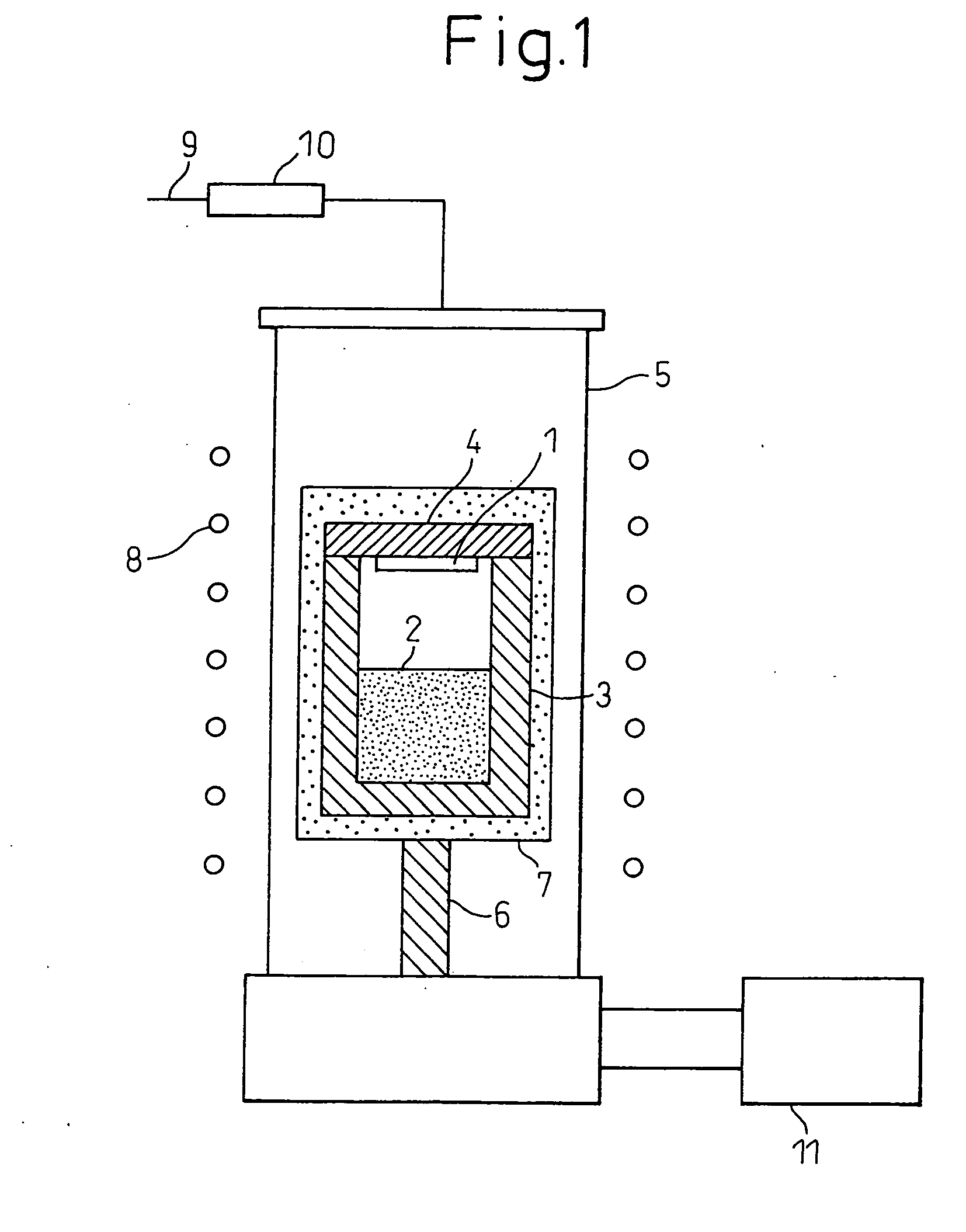Single-crystal silicon carbide and single-crystal silicon carbide wafer
- Summary
- Abstract
- Description
- Claims
- Application Information
AI Technical Summary
Benefits of technology
Problems solved by technology
Method used
Image
Examples
example 1
[0057]First, a single-crystal SiC ingot was prepared to obtain a seed crystal for conducting the crystal growth of Example 1.
[0058]A 79 mm diameter single-crystal SiC ingot was produced by a growth process using the aforesaid single crystal growing apparatus under conditions such that the nitrogen concentration in the grown crystal was 2.2×1019 cm−3 in the region 1 mm and greater away from the interface with the seed crystal. In order to obtain the desired value of the grown crystal nitrogen concentration, the partial pressure of the nitrogen gas in the atmosphere was controlled to 100 Pa from the time that the grown crystal was estimated to have reached 1 mm up to the end of growth, and the value of the partial pressure of the nitrogen gas at the start of growth was determined with consideration to the nitrogen concentration and the like of the seed crystal. Next, the so-obtained single-crystal SiC ingot to be used for seed crystals was machined to fabricate a number of 77 mm diame...
example 2
[0064]In order to prepare a seed crystal for conducting the crystal growth of Example 2 by a growth process using the aforesaid single crystal growing apparatus, a 103 mm diameter single-crystal SIC ingot was produced wherein the nitrogen concentration in the grown crystal was 5.1×1019 cm−3 in the region 2 mm and greater from the interface with the seed crystal. In this case, the nitrogen gas partial pressure was controlled to 230 Pa except at the start of growth. The ingot was machined to fabricate a number of 101 mm diameter wafers of an off-angle of 8° from the {0001} plane. Both sides of the wafers were polished, and one of the wafers was observed for etch pits. The densities of the etch pits corresponding to threading dislocations and basal plane dislocations were 6.8×103 cm−2 and 1.8×103 cm−2, respectively, and the total etch pit density caused by all types of dislocation was 8.6×103 cm−2. The etch pitch density caused by micropipes was 1.1 cm−2.
[0065]One of the remaining wafe...
example 3
[0070]A 79 mm diameter single-crystal SiC ingot for use as seed crystal was produced as in Example 1. Except at the start of growth, the nitrogen gas partial pressure was controlled to 1 kPa so as to make the nitrogen concentration in the grown crystal was 2.0×1020 cm−3 in the region 1 mm from the seed crystal.
[0071]The ingot was machined to fabricate a number of 77 mm diameter wafers of an off-angle of 8° from the {0001} plane. Both sides of the wafers were polished, and one of the wafers was observed for etch pits. The densities of the etch pits corresponding to threading dislocations and basal plane dislocations were 5.6×103 cm−2 and 1.1×103 cm−2, respectively, and the total etch pit density caused by all types of dislocation was 6.7×103 cm−2. The etch pitch density caused by micropipes was 0.06 cm−2.
[0072]One of the remaining wafers was used as a seed crystal to grow the single-crystal SiC of Example 3 by the process using the aforesaid single crystal growing apparatus.
[0073]The...
PUM
 Login to View More
Login to View More Abstract
Description
Claims
Application Information
 Login to View More
Login to View More - R&D
- Intellectual Property
- Life Sciences
- Materials
- Tech Scout
- Unparalleled Data Quality
- Higher Quality Content
- 60% Fewer Hallucinations
Browse by: Latest US Patents, China's latest patents, Technical Efficacy Thesaurus, Application Domain, Technology Topic, Popular Technical Reports.
© 2025 PatSnap. All rights reserved.Legal|Privacy policy|Modern Slavery Act Transparency Statement|Sitemap|About US| Contact US: help@patsnap.com


